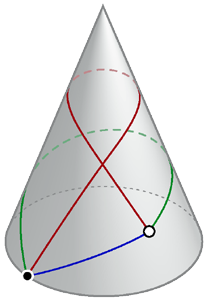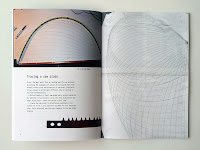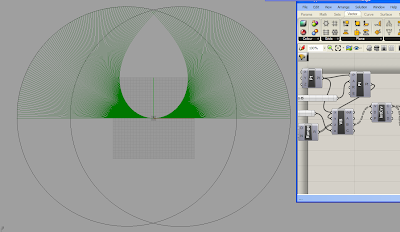2014-01-30
Calculating the curves of bending
These saw blade curves (seen in two previous posts: here and here) are arranged to have identical midpoint and when viewed like this, the endpoints of the curves all lie on two circles. The radius of each circle is 2/5 of the curve length, and the two circles are 1/5 of the curve length apart.
Based on this fact, I could use the Pythagorean theorem to formulate a mathematical relationship between the original length L, distance d between end points and curve height h:
2013-06-15
New book!
2012-12-28
2012-11-23
3 useful cones, part 2
2011-11-17
Experiments by Joe Magri

2011-08-22
Hinge Force in Kangaroo

In these examples, Kangaroo wants to flatten the meshes by trying to set the angle between each neighbouring triangles to zero. Springs make sure the surfaces don't deform. Thanks to Daniel Piker for this great force! More reading about the Hinge concept here.
2011-04-14
Exhibition opened!
Searching for the obviousMårten NettelbladtWhen you bend a thin strip of plywood you get a beautifully shaped curve. What geometry does this curve follow? There is a peaceful simplicity to the shape, and yet, it doesn't fall into the normal categories of basic geometric shapes as we know them. The exhibition shows two different ways to approach this challenge. Part one: A plywood strip, twelve meters long, curled and twisted into a double loop shape. This geometry is a result of the material trying to resist, and thereby minimize, the forces of bending and torsion. Part two: A computer generated surface, curling and twisting according to user input. Two lists of values control the curvature and the direction of the surface. The resulting single-curved surface will always be developable and unroll to a straight strip. Question: Is there a simple mathematical solution that will produce the same geometry as in the plywood loop? The search continues.Special thanks toDavid Rutten, McNeelAndy Payne & Jason K. Johnson, Firefly ExperimentsGrasshopper Forum
2011-04-08
Exhibition 14th April - 19th May 2011, Stockholm

2011-04-07
Work by Joel Letkemann
2011-04-02
smartgeometry 2011 Copenhagen
2011-03-24
2011-03-12
Comparing 5 curves
2011-03-10
2011-03-09
Work by Maarten Kuijvenhoven and Matthijs Toussaint
http://homepage.tudelft.nl/p3r3s/MSc_projects/reportKuijvenhoven.pdf
http://homepage.tudelft.nl/p3r3s/IASSpaperKuivenhovenHoogenboom.pdf (reworked into a paper)
"About three years ago I wrote my thesis at TU Delft about timber grid shells and also tried to answer what geometry an elastically bent beam will have. The problem was that standard engineering formulas for deformation of beams exist, but are only valid as long as deformations remain small. Therefore I had to work it out in a more elaborate way using the concept of minimal potential energy."Image: Maarten Kuijvenhoven
including some very nice tests with physical models:
2011-02-27
Daniel Pikers KANGAROO
Of course, this investigation is not only about mimicking bending geometry, but also about understanding it. Kangaroo brings my understanding to a new level!
2011-02-26
Kangaroo Bending + Reactivision
A video response to these photos by Amir Gazit. Thanks to Daniel Piker for this setup: Also thanks to Andy Payne and Jason K Johnson for including the Reactivision stuff in the latest FireFly. It's a lot of fun!
2011-02-24
Realtime curvature analysis of a Kangaroo bending curve
Kangaroo is a component for Grasshopper (Rhino).
2011-02-23
Kangaroo Physics "Drop shape"
Bending simulation in Kangaroo
2011-02-13
Try the Tapeworm
Raw grasshoppers should be eaten with caution, as they may contain tapeworms. http://en.wikipedia.org/wiki/Grasshopper
2011-01-15
Tapeworm script with sliders
MD-slider controlling Bending on Y-axes and twisting (left/right) on X-axes. Surface is Baked to Rhino and then unrolled to become flat and straight. Other versions here:
2010-12-18
Tapeworm script
2010-12-12
Developable curved strips in Grasshopper
2010-12-10
Scripted 3d Bending
2010-12-09
2010-11-09
Guitar string + Grasshopper scripting
2010-10-01
Bending curves inside two circles
2010-08-30
Spline definition
SPLINE: “A curve that closely approximates the shape of a strip of material that is gently bent; originally a draftsman's tool for drawing curves that represented the shapes taken by wooden and metal members of a ship's hull structure bent over fixed points or frames and, later, representing similar shapes in auto bodies and aircraft structures. A spline is the shape taken by bending material objects, like beams, that minimizes the elastic energy (or internal strain energy) stored in the beam. Mathematically, it is the smoothest curve that passes through a set of fixed points. In 3D modeling it is a curve defined by control points, often supplemented by interactive methods to modify tangents to the curve at these points and to adjust a local weighting factor. Bézier, B-Spline, and NURBS are commonly used types of splines.”
(unknown source)
2010-06-17
Analyzing the Drop shape
2010-06-14
Cornu Spiral curves scripted in Grasshopper
2010-06-13
Elastica curves scripted in Grasshopper
2010-05-31
Kangaroo Physics by Daniel Piker
2009-11-19
Developable fork
A developable fork is way to connect three developable surfaces with each other. They are joined by a flat triangle, tangent to the three surfaces (and tangent to the three edge curves). The developable fork is very useful when creating volumes from developable surfaces.
Some more images and info here.
2009-09-29
Geodesics on a Cone

Mark L. Irons did some thinking about Geodesics on a Cone.
Geodesics on a Cone is probaly the same thing as a Conic plank line.
He explains very clearly why there can be more than one geodesic line that connects two given points on a cone (or a sphere).
(Images: Mark L. Irons)
2009-08-29
From Spiral to Spline
Thanks to Ola Jaensson for finding and sharing this!
















































